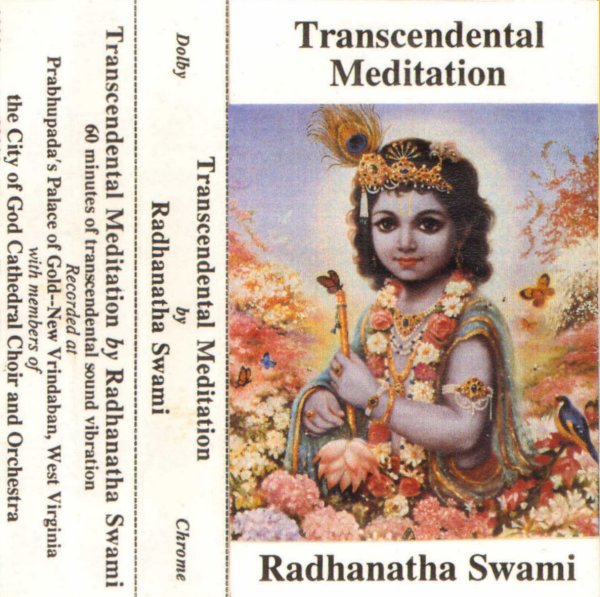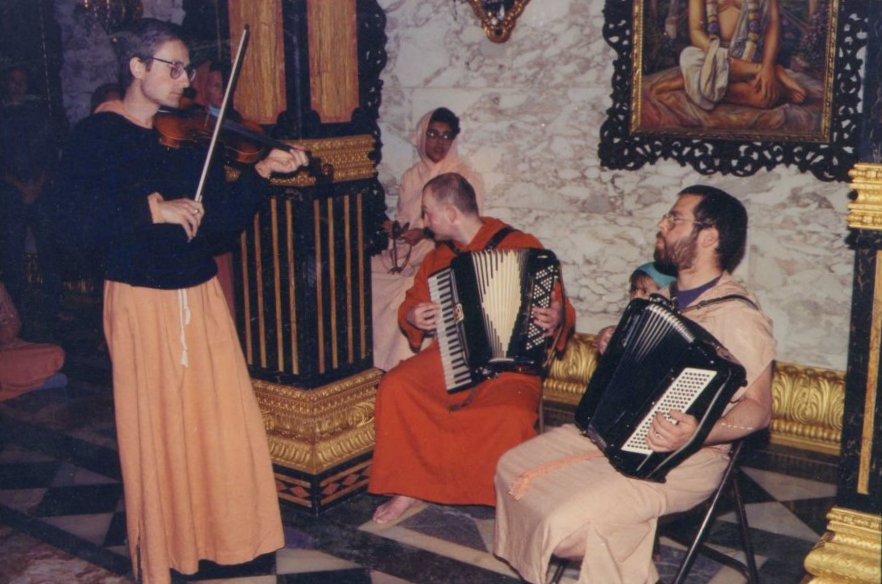Transcendental Meditation: Radhanath Swami
a cassette tape recorded in June 1992 by Radhanath Swami and members of the New Vrindaban City of God choir and orchestra

The cover of the cassette tape Transcendental Meditation by Radhanath Swami (June 1992). To listen to Transcendental Meditation, go to YouTube.
Introduction from Gold, Guns and God, Vol. 8:
IN 1991, BHAKTIPADA HAD A NEW VISION for the music at New Vrindaban; a type of music he called “Ideational.” His inspiration for the New Vrindaban City of God was that everything should remind one of Krishna, or God. The architecture should be in the mode of goodness and should have a simple but beautiful classical style. The robes of the residents should also be in goodness and reflect simplicity and austerity of dress. The food, of course, should also be in goodness: pure vegetarian Krishna prasadam, and the music should be ideational: completely free from the degrading modes of passion and ignorance.
Three cyclical ages of humankind
During the autumn of 1991, Bhaktipada read a book by the Russian sociologist Pitirim A. Sorokin (1889-1968), The Crisis of Our Age, which postulated that human history was caught in a titanic cycle of alternating materialistic and spiritual cultures, each collapsing and being replaced by the other over the span of many centuries. Sorokin defined three cyclical ages of mankind: (1) Ideational, (2) Idealistic and (3) Sensate.
According to Sorokin, the Ideational Age last appeared during the Middle Ages and was exemplified by Western medieval culture, as its major principle or value was God. Its architecture and sculpture were the “Bible in stone.” Its literature, again, was religious. Its painting articulated the same Bible in line and color. Its philosophy, almost identical with religion and theology, was centered around God. Its ethics and law were but an elaboration of the absolute commandments of Christian ethics. Its political organization was predominantly theocratic and based upon God and religion. Its family, as a sacred religious union, was indissoluble and articulated the same fundamental value. Even its economic organization was controlled by a religion prohibiting many forms of economic relationships. And its music was almost exclusively religious: Gregorian chants such as Alleluia, Gloria, Kyrie Eleison, Credo, Agnus Dei, Mass, Requiem, etc.
Sorokin claimed that at the end of the twelfth century, there emerged the germ of a new—and profoundly different—major principle: that the true reality and value is sensory. Only what we see, hear, smell, touch and otherwise perceive through our sense organs is real and has value. Beyond such a sensory reality, either there is nothing, or, if there is something, we cannot sense it; therefore it is equivalent to the non-real and the non-existent and as such, may be neglected. Sorokin called this the Sensate Age, which eventually, by the end of the twentieth century, effectively and efficiently supplanted and destroyed the former Ideational Age, relegating it to a mere vestige of its former power and influence.
During the Sensate Age, architecture and sculpture is predominantly secular. Its literature, again, is secular. Its painting, philosophy and theology is centered around man, not God. Its ethics and law are separated from God and religion. Family relationships are considered temporary and divorce is common. And its music extols the pleasures of the senses. From the hit songs of the late-nineteenth century such as My Wild Irish Rose and When You Were Sweet Sixteen, to the hit songs a hundred years later such as Erotica by Madonna and Bitch by Eminem, mention of God (or virtuous qualities like renunciation or self-control) became conspicuously absent.
Sorokin described the Idealistic Age as the time between the Ideational and Sensate ages, which lasted approximately eight centuries, from the twelfth to the twentieth centuries. Its major premise is that the true reality is partly supersensory and partly sensory; it embraces the supersensory aspect, plus the rational and the sensory aspects of human understanding.
Sorokin described an Ideational Age which, in some ways, seemed to correspond to the mode of goodness. The Idealistic and Sensate Ages seemed to correspond to the modes of passion and ignorance. Bhaktipada said he wanted to root out all sources of passion and ignorance in New Vrindaban and replace them with goodness. In 1987, television and radio—due to materialistic programming—had already been officially banned by Bhaktipada’s proclamation. (Actually television and radio had never been permitted in the community, but it had to be officially banned, as some householders began to acquire television sets during the mid-1980s.)
Bhaktipada had asked devotees to give up driving their cars in the community and ride bicycles or horses instead. He purchased a horse-drawn buggy in which he rode around the community. He also recommended that his disciples eat a salt-free diet based on pureed raw vegetables. Bhaktipada claimed, “Your diet should consist of at least one half raw foods, because cooking kills the food. No hot, spicy foods—they agitate. A little salt, but not too much.”
And Bhaktipada wanted the New Vrindaban residents to listen to sattvic music which would not agitate the senses; music which would calm the mind and passions; ideational music like Gregorian chant.
On June 24, 1992, at the request of Bhaktipada, choir members and musicians recorded a cassette of the Hare Krishna maha-mantra with Radhanath Swami as soloist. The chant, based on a tune from a recording by the popular Indian guru, Muktananda, was recorded at Prabhupada’s Palace. The marble walls in the kirtan hall provided reflective surfaces which produced an excellent natural reverberation. I wrote the musical arrangements and directed the orchestra in accordance with Bhaktipada’s concept of Ideational Music. I titled the cassette, Transcendental Meditation by Radhanath Swami: 60 Minutes of Transcendental Sound Vibration with Members of the City of God Cathedral Choir and Orchestra.
Cassette Liner Notes
Transcendental Meditation
Radhanath Swami
60 minutes of transcendental sound vibration recorded at Prabhupada’s Palace of Gold, New Vrindaban, West Virginia (June 1992) with members of the City of God Cathedral Choir and Orchestra
Liner Notes:
Radhanath Swami
Radhanath Swami was born in Chicago on December 7, 1950. While a teenager, he renounced his middle-class home and comforts and hitch-hiked to India, a solitary penniless traveler in search of the Absolute Truth. It was the autumn season and getting cold. The tourists were heading south, so he headed north and spent the winter in the caves of the Himalayan foot hills, learning meditation and accepting the ancient spiritual civilization of the Indian subcontinent on its own terms.
As time went on, this young man, traveling along the holy rivers of India with matted hair and tattered cloth, became indistinguishable from the holy Indian sadhus. Because of the common bond of attainment of spiritual perfection, he felt more bound to them than to the world he left behind.
He thus gained the association of some of the greatest saints of India. By their grace, he found his true path to God as a devotee of Lord Krishna, a path which led him to the feet of His Divine Grace A. C. Bhaktivedanta Swami Prabhupada, the founder of the worldwide Hare Krishna movement and the unequaled pure devotee and link in the chain of discipular succession coming from Lord Krishna himself. He was accepted as Swami Prabhupada’s disciple in 1973.
Radhanath Swami, a genuine babji, or renounced holy man, migrated from the East to live at the New Vrindaban Community in the Appalachian foothills of West Virginia [actually New Vrindaban is located on the Allegheny Plateau, not in the Appalachian foothills]. He considered New Vrindaban to be non-different from the original sacred Vrindaban of India—the village where Lord Krishna advented 5,000 years ago on this earth and displayed his loving pastimes with his devotees. After Swami Prabhupada left this mortal world in 1977, Radhanath Swami continued his spiritual tutelage under Prabhupada’s senior-most disciple, His Divine Grace Kirtanananda Swami Bhaktipada, the founder of the New Vrindaban Community and League of Devotees and the builder of Prabhupada’s Palace of Gold.
Radhanath Swami, who accepted the sannyasa order from Swami Bhaktipada in 1982, presently spends six months a year in India and six months in the United States preaching love of God. Radhanath Swami, beloved among devotees of Lord Krishna, holds a special place in the hearts of all who know him.
New Vrindaban, West Virginia
New Vrindaban is the headquarters of the League of Devotees, an international organization whose goal is to establish a God-centered society. The community was founded in 1968 by His Divine Grace Kiraananda Swami Bhaktipada, the first sannyasa disciple of Swami Prabhupada, the founder of the Hare Krishna Movement. After twenty-five years, New Vrindaban now covers 5,000 acres, has 200 residents, a school system, a cow-protection program, and one of the largest dairy herds in West Virginia. The community features West Virginia’s second-largest tourist attraction, Prabhupada’s Palace of God, hailed by The New York Times as “America’s Taj Mahal.”
All activities within the community are performed for the pleasure of the Supreme Lord, Sri Krishna, under the auspices of his representative Swami Bhaktipada. Visitors are welcome—indeed, all are invited—to “experience the heavenly life—even on earth.” Special festivals, which include outdoor drama, fireworks, huge feasts, and special speakers are on Memorial Day weekends, Fourth of July weekends, and Labor Day weekends. Guest rooms are available year-round with advance reservations.
For those who want to make this lifestyle theirs, basic necessities are provided with the understanding that one must adhere to four principles of morality: no intoxication, no illicit sex, no gambling and no meat eating or hunting. Daily chanting and meditation, attendance at temple worship services and performance of practical service are also required.
New Vrindaban residents are currently constructing a 300-acre City of God that will give spiritual shelter to people of all faiths. It will be able to accommodate 12,000 persons. Proposed completion date is early 21st century.
Credits:
Conceived by His Divine Grace Kirtanananda Swami Bhaktipada
Orchestra Personnel:
Music Director: Hrishikesh
Harmonium: Radhanath Swami
Tambura: Dhruva
Violin: Good Hope
Cello: Dutiful Rama
Kartals: Remuna
Mrdanga: Hrishikesh
Special assistants: Madhavendra Puri, Mahaprabhu, Mandara and Pure Bliss.
Recorded at Prabhupada’s Palace of Gold. Tape Duplication by Heid Productions.
Cover painting by Dhruva, copyright by Bhaktivedanta Book Trust.
Photography by Kumar.
Produced by Music at the Palace, 295-B Palace Road, Moundsville WV, 26041. (304) 845-0467
Other Recordings by Music at the Palace
New Vrindaban Bhajans
Blessed Assurance by the New Vrindaban Cathedral Choir
Jagad Guru by the New Vrindaban Cathedral Choir
Music by Bach and Handel
Music by Mozart
Carols for Christmas

Radhanath Swami (c. mid-1980s).

Three musicians who appear on this cassette: Hrishikesh, Dutiful Rama and Dhruva.
To listen to the cassette Transcendental Meditation featuring Radhanath Swami, go to YouTube.
| Back to: Gold, Guns and God, Vol. 8 |